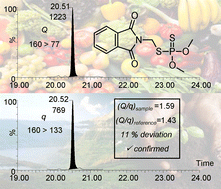
GC-MS/MS in residual pesticide analysis
The laws surrounding trace amounts of pesticide found in food and the environment are designed to protect consumers and ensure that agricultural practises do not have a detrimental effect on the natural world. Even after being washed and prepared, crops can carry residual pesticides into processed products. These compounds must be both identified and quantified at very low concentration, presenting a particular challenge to analytical chemists.
In this critical review, Felíx Hernández and researchers at the University Jaume I, Spain, examine the use of gas chromatography coupled to tandem mass spectrometry (GC-MS/MS) with a triple quadrupole (QqQ) analyzer for the identification and quantification of pesticide compounds. This technique has emerged as a reliable, highly sensitive and selective tool for pesticide analysis in a complex matrix.
The authors have identified and explored a range of instances where GC-MS/MS has been successfully employed in this way. They make comparisons in a number of areas, including sample preparation, type of analyte, and mode of analysis. The food matrices being tested range from fruit and vegetables to milk, meat, ginseng and olive oil.
To read the full article, please access the link below. This paper will be free to read until October 18th.
The role of GC-MS/MS with triple quadrupole in pesticide residue analysis in food and the environment
F. Hernández, M. I. Cervera, T. Portolés, J. Beltrán and E. Pitarch
Anal. Methods, 2013, Advance Article
DOI: 10.1039/C3AY41104D










